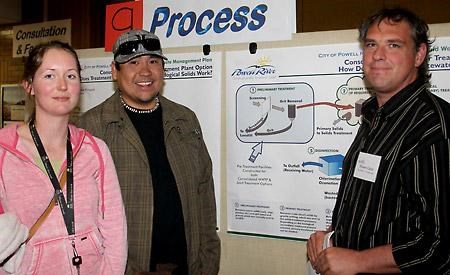City of Powell River officials displayed a great deal of information at an open house on Tuesday, May 10 about its liquid waste management plan (LWMP), but only a small percentage of residents attended.
The event, which was held at Powell River Recreation Complex, presented detailed explanations of what an LWMP is, stormwater management and the two options under consideration—a consolidated wastewater treatment plant or joint treatment, a proposal to treat city sewage at Catalyst Paper Corporation’s Powell River mill. The information also covered ways to reduce wastewater, existing facilities and a cost summary of each of the options.
Richard Stogre, manager of engineering services, said about 130 people attended the open house. The city’s population is estimated to be 13,000, which means one per cent of residents attended.
A full spectrum of information was presented, Stogre added, with a focus on the two options, joint treatment and consolidated treatment.
“City staff were very pleased with the turn out and the positive messaging that happened with the open house,” he said. “There was a good cross-section of people who attended, in terms of leading the event, meaning city staff, members of the joint local-technical advisory committee, steering committee members and a representative from the ministry of environment.”
About 115 surveys were completed, Stogre said, and a facilitator will be preparing a report about the results, as well as from a dialogue event, to present to the advisory committee. The dialogue event was held last night, May 17, past the Peak’s deadline.
Powell River Water Watch, a coalition of environmental, ratepayer and union groups established over concern about the joint treatment proposal, is asking Terry Lake, minister of environment, to ensure there is a realistic accounting of the risks in that option. The concern is that Powell River will have no capacity to treat municipal sewage if the mill closes on short notice, according to a news release issued on May 12.
Judy Watts, co-chair, said in the statement that the information presented to the public at the open house ignored critical risks. “The city’s engineering consultant has warned that the city has to have funds available to build a public treatment facility on short notice if the mill closes,” she stated. “Yet the cost estimates presented to the public avoid this critical item. Without funds to build a city plant on short notice, the city would have no way to treat its sewage in the event of a mill closure and would have to pump untreated sewage into Malaspina Strait. That would make the current problems we have with sewage treatment in Powell River seem trivial.”
Other significant costs have been excluded from the city’s cost estimates for joint treatment, according to Water Watch, including the costs involved in obtaining permits for the mill to treat septic sewage, the cost of archaeological and environmental studies to reroute sewer lines to the mill and the cost of contract management when a municipal utility is privatized.



